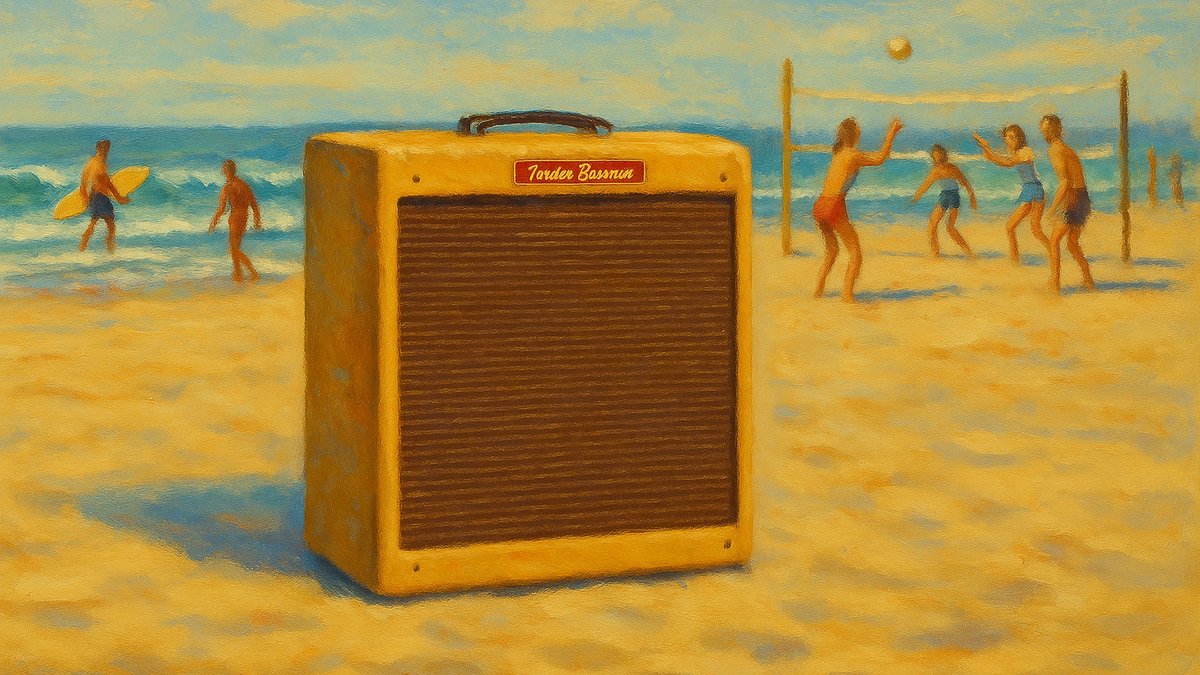
By Kevin Chisholm
Posted 06/15/2025
Fender introduced the Fender Bassman in 1952, originally as a bass amplifier for the Precision Bass. Little did they know that this amplifier would go on to become legendary, not only for bassists, but also for guitarists across genres. What started as a bass amp evolved into a staple for electric guitars, pedal steel guitars, and more, inspiring the designs of other iconic amplifiers like the Marshall JTM45, which was based on the Bassman’s revered 5F6-A circuit. Let’s dive into the evolution of this classic amp and its lasting impact on music.
The Early Days: 5B6 Bassman
The first Bassman model, the 5B6, was rolled out in 1952 with a 15-inch speaker and an amplifier chassis that pushed around 26 watts using cathode-based biasing. It featured a unique setup with a single-channel design and basic tone and volume controls, with inputs on an upper panel connected by an umbilical cord. This “TV front” cabinet design, with its classic rectangular grill cloth, also made the 5B6 visually iconic. Fender produced around 660 units from 1952 to 1954 until the 5B6’s production ended. These early amps set the stage for the Bassman’s evolution.
The Next Step: 5D6 Dual Rectifier
In November 1954, the 5D6 Bassman hit the scene, thanks to designer Freddie Tavares. Known as the “Dual Rectifier Bassman” due to its two rectifier tubes, the 5D6 also introduced four 10-inch Jensen Alnico P10R speakers, setting a new standard for bass amplification. Two key innovations included a fixed bias for the power tubes and a cathode phase inverter, which gave it a notable power boost and a clean, defined sound that made it ideal for bass and even electric guitar.
Though only a handful of these models are known to exist today, the 5D6 is remembered as a milestone that pushed the boundaries of amp design in the 1950s.
The Narrow Panel Tweed Models (1954-1960)
From 1954 to 1960, Fender produced tweed-covered Bassman models with open-back cabinets and narrow rectangular grill cloths. The first of these, the 5D6 DK, debuted in 1954. Following this were the 5E6 and 5E6-A Bassman models in 1955, each bringing enhancements that attracted guitarists for their tonal versatility.
The 5F6 Bassman, introduced in 1957, introduced several defining features, including four P10R speakers, an 83 rectifier tube, and a new 3-knob tone stack (bass, mid, and treble) that allowed more control over sound shaping. The 5F6 circuit also used a long-tailed pair phase inverter, which helped deliver cleaner tones even at higher volumes—a feature that influenced countless amps that followed.
The 5F6-A Bassman, released in 1958, holds legendary status. This model was sought after for its powerful, clear tone, and its signature 5F6-A circuit was the basis for Marshall’s first amp, the JTM45. The 5F6-A’s tonal clarity and versatility made it a favorite for guitarists and set the stage for high-gain amplifiers in the rock genre.
Fender Reissues and Modern Variations
Fender reissued the Bassman as a guitar amp in 1990 at their Corona, California facility. This reissue, designed with a solid-state rectifier and four Alnico speakers, was later shifted to Baja, California and renamed the ’59 Bassman LTD. This model kept the classic tone alive while incorporating modern construction techniques, making it popular among guitarists who wanted the classic Bassman sound with reliable, contemporary hardware.
The Piggyback Era: 6G6 Brownface Bassman
In the early 1960s, Fender introduced the 6G6 Bassman “Piggyback” amp, which earned its name due to its head-and-cabinet design. The early versions were known as Brownface amps because of their dark brown control panels, and they offered some impressive features: two 5881/6L6GC power tubes, a GZ34 rectifier, and four 12AX7 preamp tubes. The 6G6-A in 1961 introduced a solid-state rectifier and two parallel 12-inch speakers, while the 6G6-B in 1962 updated the circuitry for improved reliability.
In 1963, Fender updated the look with a Blonde Tolex covering and a tanned grill cloth. Later that year, they introduced the Blackface version, which kept the 6G6-B’s circuit and featured a black control panel and silver-and-black grill cloth. This “Blackface” design became one of Fender’s most iconic looks.
After CBS acquired Fender in 1965, they retained the Blackface circuit (AB165) before moving to the Silverface model in 1967, which offered a slightly altered tone and design, catering to changing tastes in amplification during the late ’60s and early ’70s.
Solid-State and Hybrid Models
In the 2000s, Fender introduced solid-state Bassman combos, such as the Bassman 25, 60, and 200. These were followed by the Bassman 100 and 300 models. Although these were lighter and more portable, the solid-state series did not capture the same tonal legacy as the original tube models, and most were discontinued by 2013.
The Hybrid Bassman TV series, launched in 2009, attempted to blend classic and modern designs, combining a solid-state power amp and a tube preamp. Available in several configurations, such as the Ten (10-inch, 150W), Twelve (12-inch, 150W), and Duo Ten (2×10-inch, 350W), these models aimed to deliver that iconic Bassman sound in a more versatile, gig-ready package.
Summary
The Fender Bassman is more than just an amplifier; it’s a defining piece of music history that has influenced sound across generations. From its early days of amplifying the Precision Bass to becoming the foundation for high-gain rock amplifiers, the Bassman’s influence can still be heard in music today. It remains a go-to for guitarists who appreciate its rich tone, rugged build, and role in shaping the world of electric guitar amplification.
If you’re ready to explore more about classic amps and their technical details, subscribe to Humbucker Soup for the latest tips and deep dives into the art of guitar tone.
